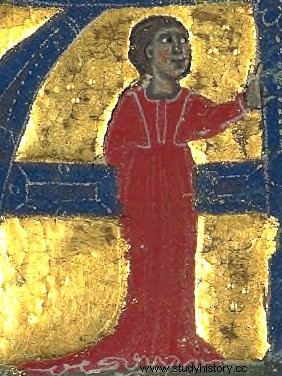Active in the XII th century, Azalaïs de Porcairagues composed poetry and sang courtly love in the courts of Occitania. She is considered the first troubadouress whose name is known to us.
Troubadouresses
 It's in Occitania, in the XI
th
century, that the troubadour movement was born. An emblematic figure of the Middle Ages, the troubadour was a poet, a musician and a composer of songs in the langue d'oc that he interpreted or had interpreted at court by a juggler or a minstrel. In the age of courtly love, the troubadours sing the fin’amor , the exploits of knights, romantic relationships.
It's in Occitania, in the XI
th
century, that the troubadour movement was born. An emblematic figure of the Middle Ages, the troubadour was a poet, a musician and a composer of songs in the langue d'oc that he interpreted or had interpreted at court by a juggler or a minstrel. In the age of courtly love, the troubadours sing the fin’amor , the exploits of knights, romantic relationships.
Troubadour art includes many genres, the most popular of which is the canso , a form of musical lyric poetry consisting of five to seven stanzas of varying length. Born in the heart of the Occitan nobility, the troubadour movement spread to Italy, Spain and northern France. The troubadours became important actors in social and cultural life, so much so that they remain an essential figure of the Middle Ages today.
Among them are women. History remembers the name of twenty-three trobairitz , or troubadouresses, who write, compose and interpret. They are considered the first Western women to write secular music. Coming from the nobility, they also sing about love, the great epics, sometimes political subjects.
A few lines of a vida
Azalaïs de Porcairagues is considered the first troubadouress whose name is known to us. His life remains mostly a mystery; the little information that has reached us is contained in a few lines of a vida , a prose text recounting the life of a trobairitz or a troubadour. The vida of Azalaïs relates:
“N’Azalais de Porcarages si fo de l’encontrada de Monpeslher, gentils dòmna et ensenhada. And enamorèt se d'En Gui Guerrejat, que èra fraire d'En Guilhem de Monpeslher. E la dòmna si sabia trobar, et fez de lui mantas bonas cansós. »
(Azalaïs de Porcairagues, a noble and cultured lady, came from the Montpellier region. She was in love with Gui Guerrejat, the brother of Guillaume de Montpellier. She knew how to compose and wrote many beautiful songs for him.)
Only one song by Azalaïs de Porcairagues has come down to us. Satornada , its last verse, mentions the benefactress of the troubadours Ermengarde de Narbonne, indicating that Azalaïs had probably attracted, by her talent, the protection of a patron.

“Here we come to the cold weather”
Azalaïs' song is probably addressed to Gui Guerrejat, mentioned in his vida . It seems to mention the death of a cousin of Gui, the troubadour Raimbaut of Orange, who died in 1173.
Ar em al freg time vengut,
Que ‘l gèls e’l nèus e la fanha,
E l’aucelet estàn mut,
Qu’us de chantar non s’afranha;
E son sec li ram pels please,
Que flors ni folha no’i nais,
Ni rossinhols non i crida
That in May it repelled me.
(We have come to cold weather,
With frost, snow, mud.
The birds are silent,
They don't want to sing anymore.
The branches are dry ,
They no longer have flowers or leaves.
The nightingale no longer sings,
he who in May wakes me up.)
